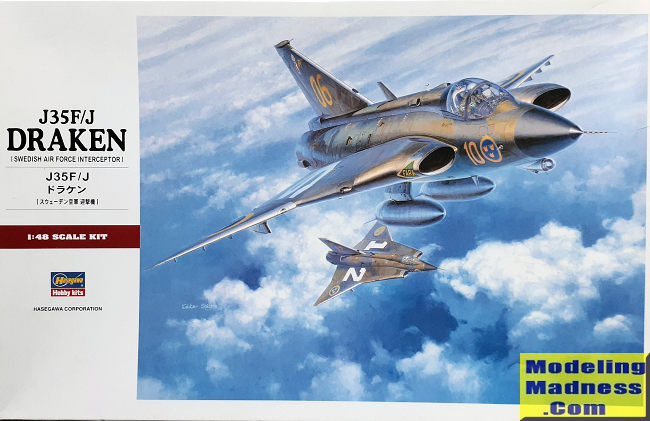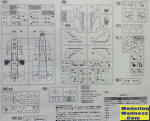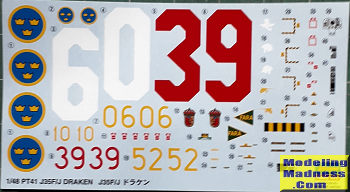
Hasegawa 1/48 J.35F Draken
| KIT #: | 07241 (Pt41) |
| PRICE: | $ |
| DECALS: | Three options |
| REVIEWER: | John Summerford |
| NOTES: | 2008 release |

| HISTORY |
The Saab 35 Draken “Dragon” was a Swedish fighter aircraft developed and manufactured by Saab between 1955 and 1974. It was the first fully supersonic aircraft to be deployed in Western Europe and the first aircraft to do the Cobra maneuver.
The Draken was developed during the 1940s and 1950s to replace Sweden's first generation of jet-powered fighter aircraft, the Saab J 29 Tunnan and, later, the fighter variant (J 32B) of the Saab 32 Lansen. It featured an innovative double delta wing. Developed in Sweden, the Draken was introduced into service with the Swedish Air Force on 8 March 1960 under the designation J 35, the prefix J standing for Jakt which translates to pursuit. Early models were intended purely to perform air defense missions, the type being considered to be a capable dogfighter for the era.
The Draken functioned as an effective supersonic fighter aircraft of the Cold War period. In Swedish service, it underwent several upgrades, the ultimate of these being the J 35J model. By the 1980s, the SAF's Drakens had largely been replaced by the more advanced Saab 37 Viggen fighter. The last Draken was retired in December 1999. The type was also exported to Austria, Denmark, Finland, and the United States; the last operated the type as a training aircraft for test pilots. [In Mojave, California, one can be found on display at the airport entrance.
| THE KIT |
 Sealed
in two bags are two sprues of 52 light gray parts that are mostly the main frame
parts. A second bag of seven smaller sprues hold the rest of the 47 parts. A
third bag has the clear parts and decal sheet composed of markings and cockpit
details. Mold seams are minimal and flash is not present. Detail is petite and
panel lines are recessed. The kit does not have any photo-etch parts.
Sealed
in two bags are two sprues of 52 light gray parts that are mostly the main frame
parts. A second bag of seven smaller sprues hold the rest of the 47 parts. A
third bag has the clear parts and decal sheet composed of markings and cockpit
details. Mold seams are minimal and flash is not present. Detail is petite and
panel lines are recessed. The kit does not have any photo-etch parts.
An after-market ejection seat might be worth purchasing since a harness is not included. Drop tanks and weapon pylons are supplied, but the weapons have to be purchased separately. Mounting holes for those stations have to be drilled out of the bottom fuselage half. A nice note is a call-out for three grams of ballast to add to the nose cone.
 A brief
history in English and Japanese plus a parts map can be found on the first face
of the three-fold, double-sided instructions. Assembly is completed in nine
steps. Painting and decaling instructions are for three aircraft. The camouflage
scheme calls for olive green and midnight blue on the upper surfaces and to my
eye they appear to be too light. According to images in the book
Swedish Jet Fighter Colours,
there was also a tri-color scheme of dark green, dark gray and dark blue upper
with neutral gray and natural metal on the lower surfaces.
A brief
history in English and Japanese plus a parts map can be found on the first face
of the three-fold, double-sided instructions. Assembly is completed in nine
steps. Painting and decaling instructions are for three aircraft. The camouflage
scheme calls for olive green and midnight blue on the upper surfaces and to my
eye they appear to be too light. According to images in the book
Swedish Jet Fighter Colours,
there was also a tri-color scheme of dark green, dark gray and dark blue upper
with neutral gray and natural metal on the lower surfaces.
| CONCLUSIONS |
This is a typical Hasegawa kit, so there shouldn’t be any surprises during construction. Be sure to check the colors of the aircraft being modeled.
John Summerford
August 2020 Copyright ModelingMadness.com If you would like your product reviewed fairly and
fairly quickly, please
contact
the editor or see other details in the
Note to
Contributors.